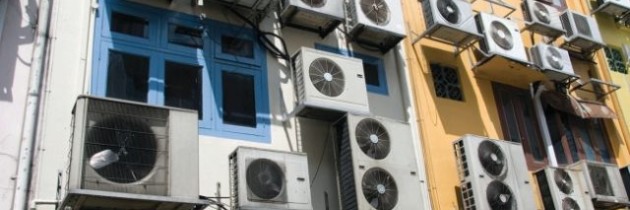Why our planet needs energy efficient cooling and HFCS phase out
Maxime Beaugrand, Law Fellow, and Durwood Zaelke, Director of the Institute for Governance and Sustainable Development (IGSD), explain why we must move away from dangerous cooling chemicals to more energy efficient solutions, in order to cut costs and global carbon emissions. This is part of The Climate Group’s Home2025 project.
As our climate warms, the need for cooling equipment – such as air conditioners and refrigerators, is growing. Increases in income and a growing middle class in emerging economies further add to the demand for cooling equipment
In particular, the air conditioning market is growing by 10-15% every year in many emerging economies, including India, China, and Brazil. Nearly three-quarters of all Indian households are projected to own a room air conditioner by 2030, up from only 4% in 2010. Under current trends, it is estimated that an additional 700 million air conditioning units will be added by 2030, and another 1.6 billion by 2050.
The electricity needed to run the growing demand for air conditioning is putting even greater strain on these countries’ weak grids. Proportionally, room air conditioning is the largest contributor to peak load electricity use from household appliances – and can account for 40-60% of peak summer energy load in cities with hot climates, such as New Delhi.
In many countries, and particularly those with the fastest growing air conditioning markets, the majority of electricity is still produced with dirty fossil fuels such as coal. Over its lifetime, CO2 emissions from the production of electricity to run an air conditioner can represent as much as 80% or more of its total climate impact.
But focusing on the energy consumption of air conditioning alone does not reveal the full scale of potential climate impacts from increasing cooling demand, nor the full scale of the opportunity for mitigation.
In addition to the energy consumption of air conditioning units, consideration must be given to the refrigerant gases used in these cooling units: in particular, the climate damaging hydrofluorocarbons, or HFCs.
HFC PHASE OUT
HFCs are factory made chemicals used as refrigerants. They were developed by industries to replace chlorofluorocarbons (CFCs) that had already been phased out – and HCFCs that are currently being phased out under the Montreal Protocol. CFCs and HCFCs destroyed stratospheric ozone, and caused significant climate warming.
While HFCs have limited effect on the ozone layer, they are very powerful greenhouse gases that trap thousands of times more heat in the atmosphere per unit of mass than CO2. And unfortunately HFC growth is accelerating by 10-15% globally, as demand grows for the appliances that use these refrigerants.
HFCs and other fluorinated greenhouse gases are actually the fastest-growing climate pollutants in many countries, including the US, EU, Australia, China, and India.
This continued HFC growth will add up to 0.1°C of global average temperature rise by mid-century, which will increase up to five-fold to 0.5°C by 2100.
And if left unchecked, by 2050, annual HFC emissions could be equivalent to 12% of annual CO2 emissions under a business-as-usual scenario, and up to 71% under the Intergovernmental Panel on Climate Change’s strongest mitigation scenario.
But solutions exist today. The Montreal Protocol, which has already phased out nearly 100 other fluorinated gases by nearly 100 percent, is ready to phase down HFCs. Parties to the Montreal Protocol are working under an accelerated schedule this year, with a view to concluding an amendment to phase down HFCs at the Meeting of Parties in Kigali, Rwanda in October. There are many alternative refrigerants coming into the market with superior climate performance.
There also are solutions to improve the efficiency of air conditioning and other appliances. According to Lawrence Berkeley National Laboratory, a combined transition to low-GWP (global warming potential) refrigerants and higher efficiency air conditioning could produce energy savings in peak demand equal to between 544 and 1,270 gigawatts (GW) of electricity by 2050.
This would avoid – or free up for other uses – an amount of electricity equal to the production of between 680 and 1,587 medium-sized peak-load coal power plants by 2030, and between 1,090 and 2,540 by 2050.
ENERGY SAVINGS
Globally, these energy savings are huge. Over the next 15 years, the potential savings in India alone from improving the energy efficiency of room air conditioning is the equivalent of up to 142 new medium-sized (500 MW) coal power plants. Other countries would also see significant energy savings.
These efficiency gains would lower the cost of operating air conditioning, ease pressure on overloaded electricity grids and save consumers money.
Thankfully, low-GWP alternatives are widely and increasingly available. In the room air conditioning sector, thousands of hydrocarbon units have been sold and new production lines are developing each year. The Indian manufacturer, Godrej, and Chinese manufacturer, Gree, have developed models of propane (HC-290) room air conditioners. The Godrej models are up to 11% more efficient than the minimum requirements for the 5-Star energy efficiency rating set by the Indian Bureau of Energy Efficiency. China, Japan, India, Indonesia and other countries have also commercialized products using moderate -GWP HFC-32 with high levels of energy efficiency.
The combined switch out of HFC refrigerants and improvements in energy efficiency of air conditioners will provide what many experts believe will be the single biggest piece of climate mitigation in the near-term. This makes it a powerful down payment on the Paris Agreement, and provides a solid foundation for an ambitious COP 22 in Marrakech, which will be focusing on the need for near-term mitigation.
The Clean Energy Ministerial (CEM) launched the Advanced Cooling Challenge (AC Challenge) in June at CEM7 in San Francisco. This campaign challenges governments, companies, and other stakeholders to develop and deploy at scale super-efficient, smart, climate-friendly, and affordable cooling technologies that are critical for prosperous and healthy societies. As the CEM secretariat is moving in the offices of the International Energy Agency (IEA) in Paris, we can expect strong synergies including further work on both the technical and the policy side, including for instance an updated road map.
Fonte: The Climate group



